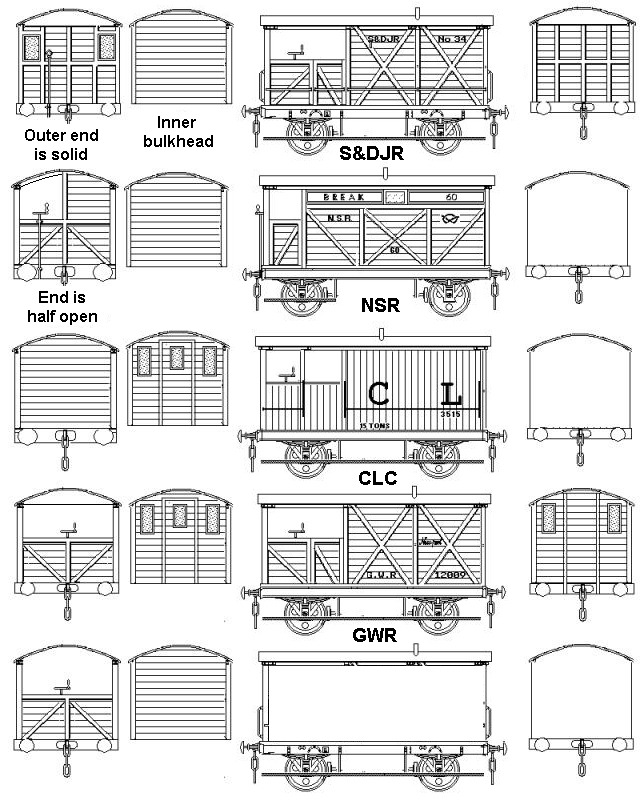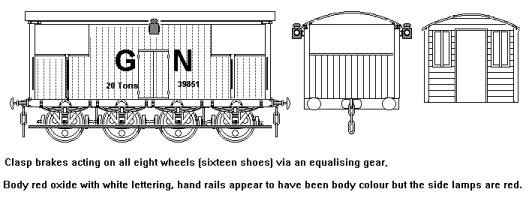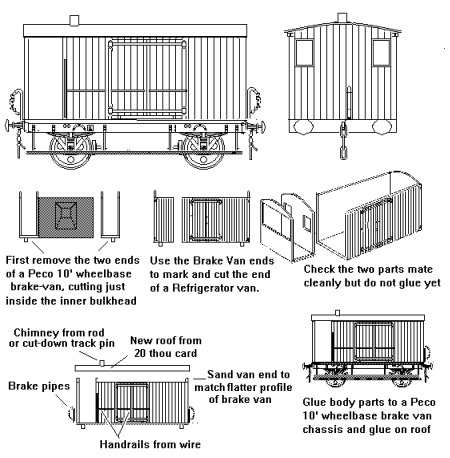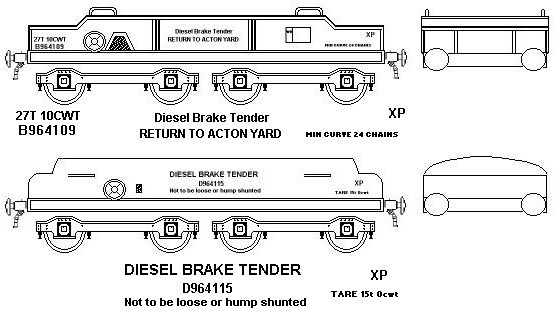Brake Vans and Brake
Tenders
Break vans (this spelling was used until about 1870)
appeared in the mid 1840's. The brake van served two purposes, it provided
additional braking for 'unfitted' goods trains and put at man (the guard) at
the rear of the train who could take action in the event of a breakdown or
accident.
The early goods brake van was a heavily weighted wagon
equipped with a hand operated brake acting on all four wheels. The guard was
provided with a small hut on the wagon (hence the term 'van') but the open
'verandas' at one or both ends were not originally roofed in. Veranda roofs
appeared in about 1870 and soon became the norm but on most vans the sides and
ends of the verandas were left open. Not all vans had open verandas however,
and some of those which did actually had closed ends, albeit equipped with
windows. The examples shown have been chosen to illustrate a number of van
designs.
The brakes on the van were normally controlled using a hand
wheel which was usually mounted in the open vestibule. On some early designs
the operating shaft was mounted on the outside end of the vehicle, as shown on
the NSR van in the sketch.
To improve the guards visibility many vans
were fitted with look-outs on the sides or roof, side look-outs (often called
duckets) were the more common but the North Eastern Railway, Great Central
Railway, London Brighton and South Coast Railway and the Lancashire &
Yorkshire Railway all built some vans with a raised look-out at one end of the
roof.
Fig ___ Brake Vans

To improve braking power some vans were built with six
wheels and the Great Northern Railway built a few eight wheelers for the heavy
coal trains feeding London from the North Eastern coal fields. These were the
only rigid eight wheelers built in Britain but in the 1930's the London Midland
& Scottish railway but three bogie vans for use on a particular branch line
(where they replaced pairs of four wheeled vans) and the Southern Railway built
some bogie brake vans on redundant electric locomotive chassis. The LMS vans
had a central body similar to their standard van, complete with side duckets,
but at each end there was a lengthened vestibule similar in appearance to those
seen on GWR brake vans. The SR vans were designed for high speed operation
rather than stopping power, they had a lengthened cabin similar in appearance
to the Peco SR brake van kit body (including the sanding boxed on each end)
mounted on a redundant electric locomotive chassis with two four wheeled
bogies.
Fig ___ Great Northern Eight Wheel Brake Van

Another way of improving the
brake power was to add weight to the vehicle, typically by fitting a box under
the chassis and filling this with scrap metal. Some companies experimented with
metal sheeting added to the sides to increase, these were not common but I do
know the Lancashire & Yorkshire Railway also had some four wheeled vans
clad in steel sheet metal.
The operational use of brake vans is more
fully discussed in the section on Freight Operations, briefly they were
attached to the tail of all goods trains until the 1970's, after which they
were only used on unfitted or part-fitted trains. With increasing speeds on all
air braked stock the existing vans were found to be unsuitable but as agreement
had been reached with the unions on transferring the guard to the rear cab of
the locomotive no new air braked vans were built. In 1985 the rail unions
agreed to single man operation of some freight trains, the first time trains
had not had a guard on board for over one hundred and fifty years. Brake vans
were still required on trains carrying dangerous chemicals up to the late
1990's and there were quite a few still in service at that time.
Brake
vans were a mixed bag and for a light railway you can get away with virtually
any design you like. The models in the photograph were made using the body from
a Peco SR brake van kit (I needed a chassis in a hurry and had to buy the brake
van kit to get one). The outside framed van is inspired by a photograph in
Peter Tatlow's book on LNER wagons (see Bibliography). It uses the body of the
van with one veranda cut off, mounted on a shortened Peco wagon chassis with
the outside framing added from plastic strip and veranda doors from scribe
card. Its function on the layout was to accompany a rake of short end-door only
wagons which ran from the colliery to the docks. The footboards used to extend
to the ends of the body at the veranda end but after a couple of years being
handled by youngsters they broke off and I haven't got round to replacing them.
The larger van uses the left over veranda mated to the end of a cut down Peco
'standard van' body, mounted on a Peco ten foot wheelbase brake van chassis.
This van has side doors, allowing it to be used to carry general goods on the
line, several companies used such vans, usually calling them something like
'road vans'. Further details on this practice will be found in the section on
Freight Operations. The livery is actually a darker red than appears in the
photograph as the light used was not a daylight bulb.

Using the SR
van meant that I had to cut 4mm lengths of Peco sleeper and use them to mount
the couplings on the chassis before fitting the body. If making the side door
brake van it is much easier to use the LMS brake van as shown in the sketch
below.

One odd footnote to the
brake van story is that in the fifties and sixties British Railways used to
offer rides on trains made up of several brake vans for enthusiasts. Obviously
this was confined to branch lines but a rake of vans rolling along makes a
change. The enthusiasts would crowd onto the verandas so unless you have enough
spare vans I suggest you tell people the rake is on its way to the pick up
point. In the illustrations have seen showing this the locomotive was
displaying Class A (express passenger) lamps.
Brake Tenders
The new main line diesel
loco's began to appear in the 1950's but they were lighter than their steam
counterparts and so offered less braking power on an unfitted train. The
majority of existing goods stock was still not fitted with an automatic brake
so special 'brake tenders' were produced in the early 1960's.
These
consisted of a simple but sturdy chassis running on passenger bogies, equipped
with vacuum brakes and loaded with scrap metal as ballast. Early versions had a
rather square box shape, later versions were fitted with a streamlined casing.
They were coupled to the locomotive but could be either pushed ahead
of the loco or placed between the locomotive and the wagons. From the later
1960's the latter seems to have been the most common arrangement. Particularly
heavy unfitted trains were sometimes supplied with two tenders, these were
usually positioned on either side of the locomotive.
Brake tenders
appeared in a range of liveries, green with red ends was one common scheme
followed by all-over rail blue (mostly without any yellow on the ends) under
the Corporate Livery. Brake tenders were phased out in the later 1970's as
unfitted trains became increasingly rare.
A whitemetal kit of a brake
tender is available from Knightwing although I would suggest it is easier to
mount this on two Graham Farish passenger bogies rather than struggle with the
kit bogies.
Fig ___ Brake Tenders

^
Go to top of page
International Good Guys ~ Making the world a
better place since 1971 ~ Site maintained by

All material Copyright © Mike
Smith 2003 unless otherwise credited




